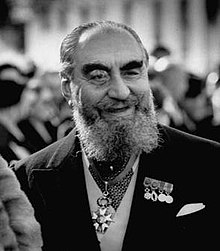Nubar Gulbenkian
Nubar Gulbenkian | |
|---|---|
 | |
| Born | Nubar Sarkis Gulbenkian 2 June 1896 |
| Died | 10 January 1972 (aged 75) Cannes, France |
| Nationality | Armenian British |
| Education | Harrow School |
| Alma mater | Trinity College, Cambridge |
| Occupation | Businessman |
| Spouses |
|
| Parent | Calouste Gulbenkian |
Nubar Sarkis Gulbenkian (
Early years
The son of
Gulbenkian was living in what became
Business

Gulbenkian began as an unpaid worker for his father, who was as noted for his miserly tendencies as his son would be for his spending, but later sued his father for $10 million, bizarrely after a refusal by the company to allow him $4.50 for a lunch of chicken in tarragon jelly.[8] Ultimately the incident contributed to Calouste Gulbenkian's decision to leave $420 million of his fortune to the Calouste Gulbenkian Foundation in Portugal.[8]
Although he ultimately inherited $2.5 million from his father, as well as more in a settlement from the Foundation, Gulbenkian also became independently wealthy through his own oil dealings.
Eccentricity
Gulbenkian's long beard, monocle and the orchid in his buttonhole which was replaced daily led to him becoming noted for a fairly eccentric life, with a number of stories building up around his name. Indeed, his character was summed up by an associate who claimed that "Nubar is so tough that every day he tires out three stockbrokers, three horses and three women".[8] He was a regular face on the international playboy scene.[citation needed]
An aficionado of the London taxi, he frequently stated that 'It turns on a sixpence, whatever that is!' He had two Austin FX4 cabs converted to his own specifications, with the passenger compartment re-modelled as the rear part of a horse-drawn Hackney carriage, and despite their somewhat bizarre appearance, one of the vehicles sold for £23,000 in 1993.[10]
He was an early guest of
A well-known gourmet, he was quoted as saying that 'the best number for a dinner party is two – myself and a damn good head waiter.'[13] Other stories attached to his name include stating his "position in life" on a market research form as "enviable".[citation needed]
Personal life
He was married three times, "I've had good wives, as wives go, and as wives go, two of them went". In 1922, he married Galician socialite Herminia Elena Josefa Rodríguez-Borrell Feijóo. In 1928, he married Dora Freeland (aka Doré Plowden) in London.[14] He courted Marie Berthe Edmée de Ayala, daughter of the French champagne tycoon Louis d'Ayala, for 14 years before they married in 1948. He had no children.[15]
He lived at Arlington House, a block of flats close to London's Ritz Hotel, and at a former rectory in Hoggeston, near Bletchley, Buckinghamshire.[15]
He died on 10 January 1972 at the English Hospital in Cannes, France, and had lived nearby at his "sumptuous estate" the Domaine des Colles at Valbonne.[15]
Will
Controversy continued to follow him after his death due to the vague nature of his father's
References
- ^ "Obits: "Gu" – "Gz"". Caskets on Parade. C.O.P. Audit Committee. 1 April 2007. Retrieved 28 January 2008.
- ^ "A man with a passion for Rollers". The Daily Telegraph. 14 February 2004. Retrieved 9 March 2016.
- ^ Gulbenkian, Nubar S. (1965). Pantaraxia: The Autobiography of Nubar Gulbenkian. Hutchinson & Company. p. 10.
I was their first-born. I was only a few weeks old when we left Kadi Keui and fled from Turkey, for the year 1896 was the time of the Armenian massacres.
- ^ a b N. Gulbenkian, Portrait in Oil: The Autobiography of Nubar Gulbenkian, New York: Simon and Schuster, 1965
- ^ Neave, pp. 63-65
- ISBN 9780275969554. Retrieved 16 January 2020.
- ^ Neave, Airey; Greenwood Publishing Group The Escape Room, regained; New York; 1969, pp. 62-64.
- ^ a b c d e "Last of the Big Spenders". Time. 24 January 1972. Archived from the original on 25 December 2007. Retrieved 28 January 2008.
- ^ Sherri Greene Ottis, Silent Heroes: Downed Airmen and the French Underground, p. 78
- ^ Adams, Keith (12 July 2011). "Specialist conversions". Austin Rover Online. Retrieved 20 January 2019.
- ^ Asa Briggs The History of Broadcasting in the United Kingdom, Volume V, Oxford University Press, 1995, p. 170
- ^ Burnett, Hugh (23 November 2007). "Nubar Gulbenkian interview". Memoryshare. BBC. Retrieved 28 January 2008.
- ^ "Nubar Gulbenkian quotes". ThinkExist.com Quotations. Retrieved 28 January 2008.
- ^ Person Details for Nubar S Gulbenkian
- ^ a b c Krebs, Albin (12 January 1972). "Nubar Gulbenkian, Oil Millionaire, Dies". The New York Times. Retrieved 4 February 2017.
- ^ Alastair Hudson, Equity & Trusts, p.95
